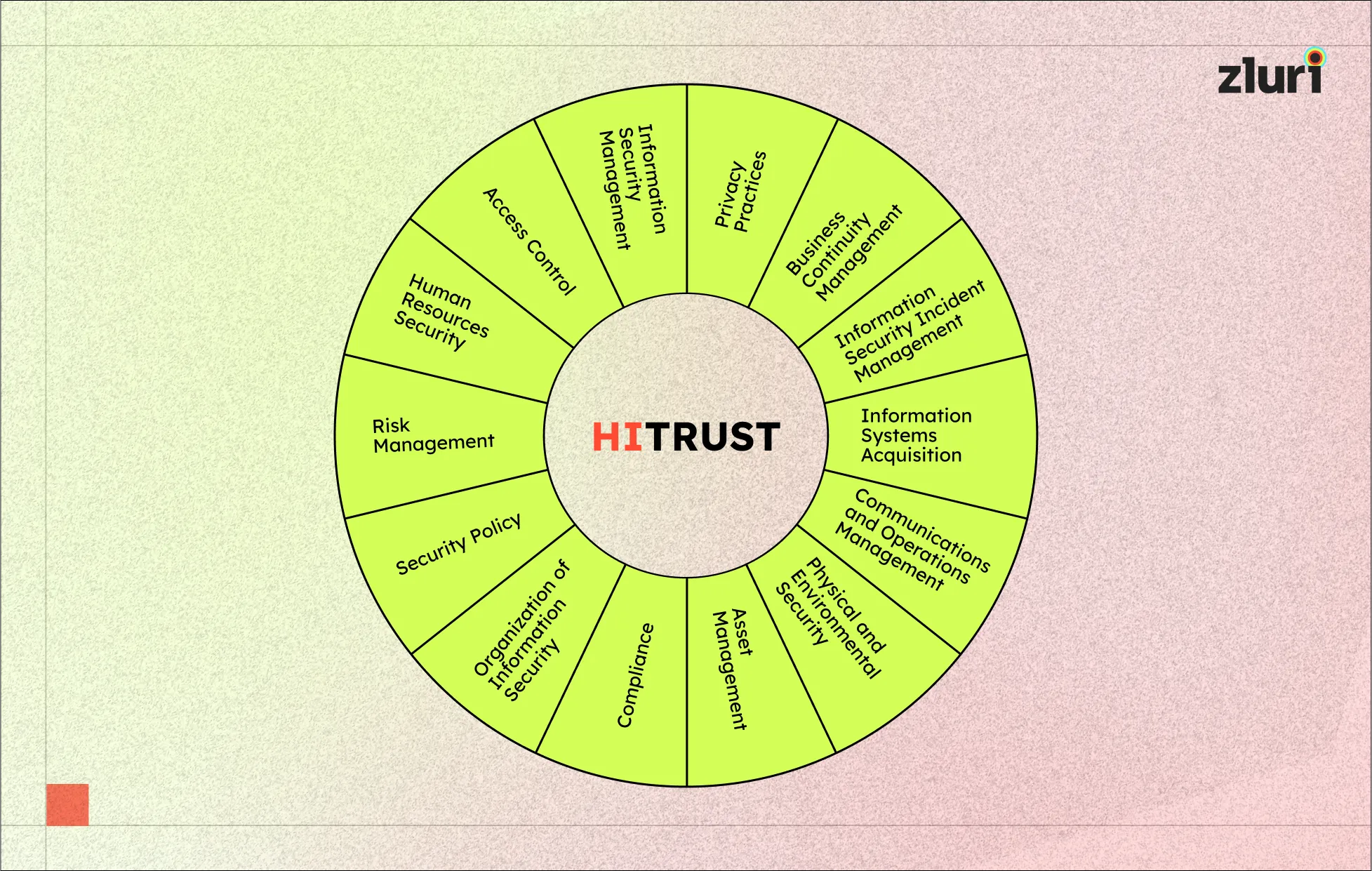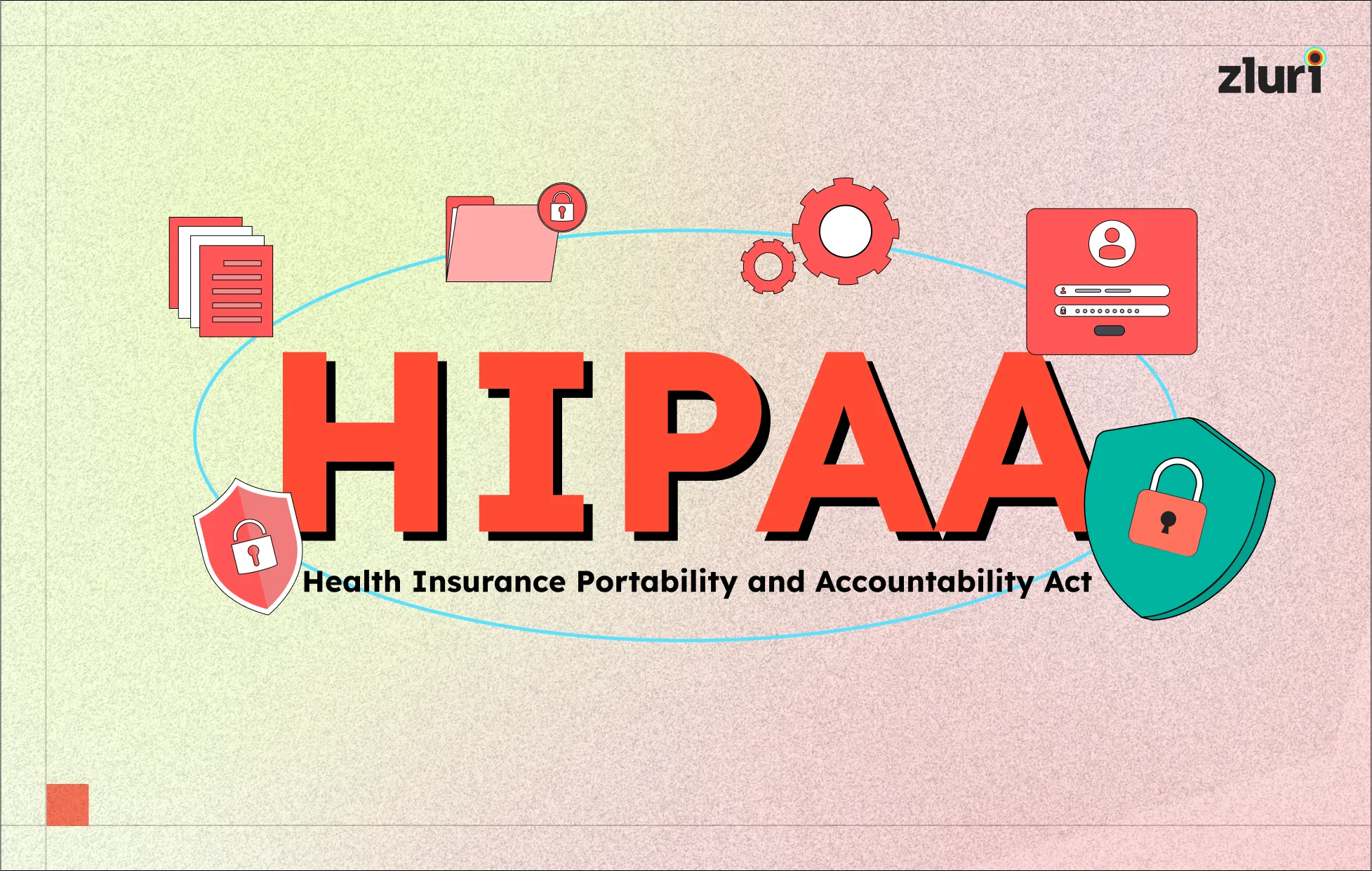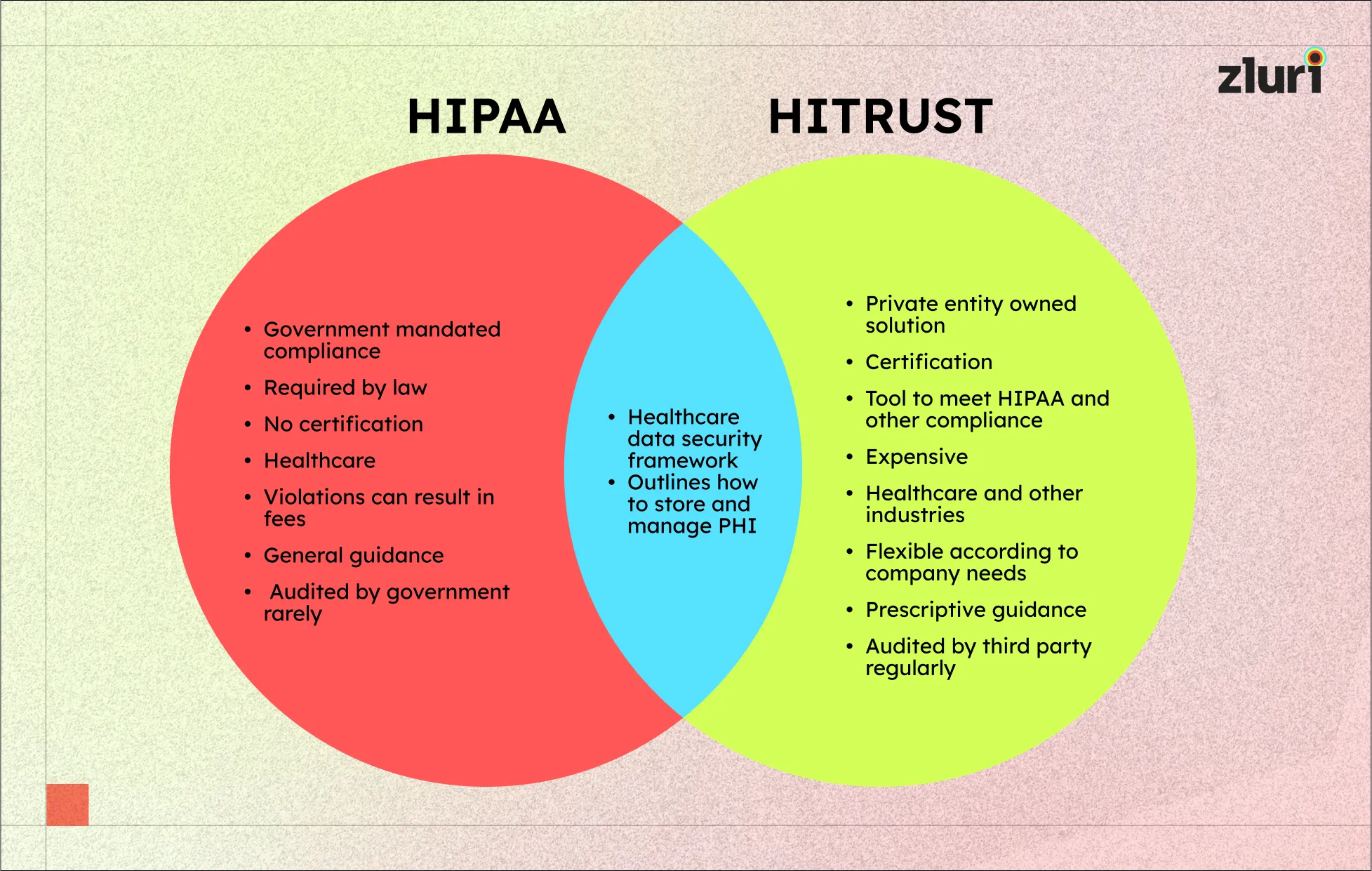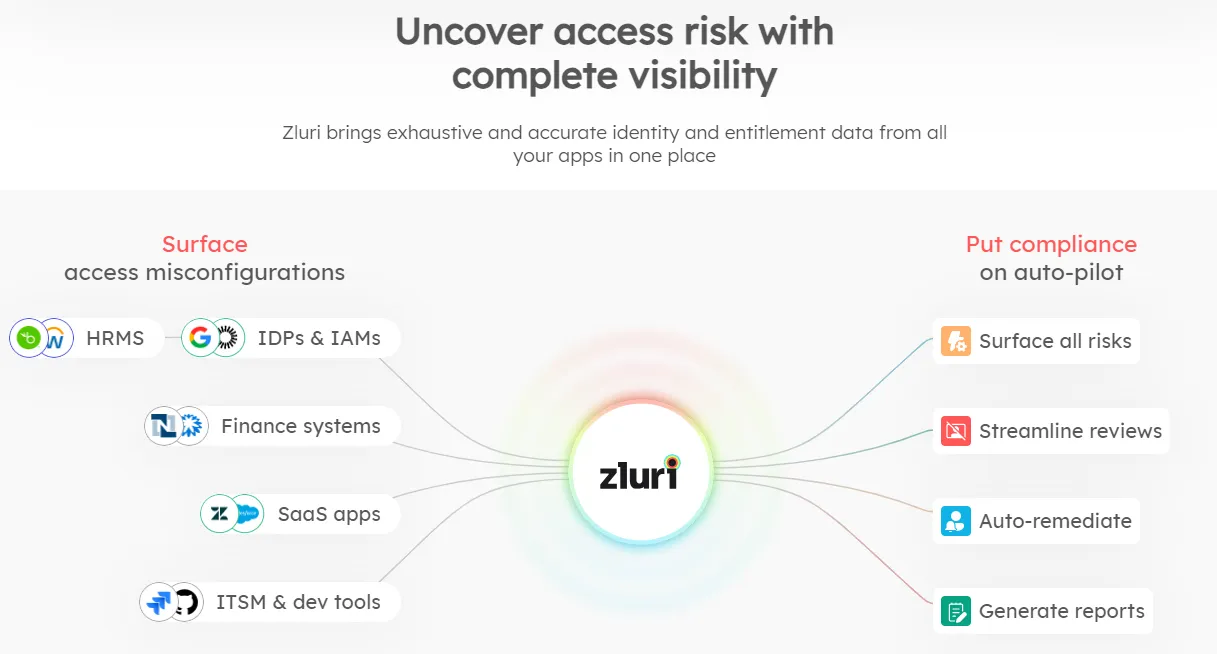HIPAA and HITRUST are frequently used interchangeably within the healthcare sector. While both aim to safeguard protected health information (PHI) and share similar objectives, their scope and application differ. In this article, we'll understand what sets HITRUST vs HIPAA apart.
HITRUST and HIPAA are two acclaimed compliance regulations. While both aim to secure Protected Health Information(PHI), they use different security practices and require the fulfillment of distinct criteria to achieve compliance. What are these security practices and mandatory requirements?
Let's find out.
What Is HITRUST?

The Health Information Trust Alliance (HITRUST) is a framework that mandates healthcare organizations to conduct thorough risk assessments. These assessments are crucial in managing and securing critical healthcare information, safeguarding it against potential threats and vulnerabilities.
That's not all; it offers other benefits as well, some of which are listed below.
Benefits Of Complying With HITRUST
Below listed are the benefits of complying with HITRUST:
- Simplifies Compliance Management
The HITRUST CSF covers multiple regulatory frameworks, allowing organizations to meet various regulations simultaneously. HITRUST's motto is \"Assess once, report many.\"
- Manages Third-Party Risk With Ease
HITRUST certification allows organizations to join the HITRUST Third-Party Assurance Program, which streamlines the process of evaluating and managing third-party vendors, saving time and resources.
- Provides Lower Charges For Cybersecurity Insurance Premiums
Because of HITRUST's strong reputation, certified companies often enjoy lower cybersecurity insurance premiums and may receive better coverage terms.
What Is HIPAA?

The Health Insurance Portability and Accountability Act (HIPAA) was introduced into U.S. law by President Bill Clinton to address two major healthcare issues:
- Ensuring health insurance coverage for employees transitioning between jobs. Without HIPAA, these individuals might be left without health insurance, making it more difficult to afford necessary healthcare.
- safeguarding protected health information (PHI) to prevent healthcare fraud. To ensure data security, it introduced the HIPAA Privacy Rule. These rules include essential regulations on how healthcare organizations store, handle, access, and share patient information.
Note: HIPAA compliance involves securing both PHI and electronic health records, also known as ePHI.
Additionally, HIPAA also mandates organizations to follow its five golden rules:
- Security Rule: This rule states that physical, administrative, and technical safeguards for secure PHI should be set up.
- Privacy Rule: This rule limits or restricts who can access and share PHI.
- Breach Notification Rule: This rule mandates organizations to inform affected individuals within 60 days of discovering a breach.
- Enforcement Rule: Outlines the procedures for investigating complaints and violations.
- Omnibus Rule: This rule gives patients more control over their health records, such as who can access their data and when.
But what benefits will organizations get from complying with HIPAA? Here's what.
Benefits Of Complying With HIPAA
Below are the benefits that you can get by complying with HIPAA:
- Makes Use Of Standardized Formats For Transactions To Reduce Errors
HIPAA mandates the use of standardized formats for electronic transactions like claims, eligibility checks, and payments. This standardization streamlines administrative tasks, reduces errors, and enhances communication among healthcare providers, insurers, and others involved, improving clinical efficiency.
- Creates Data Security Guidelines To Uphold Privacy
HIPAA provides guidelines for securely storing and managing data to uphold patient privacy while granting necessary access to care providers, insurers, and authorized individuals for clinical operations. This helps ensure better healthcare delivery.
- Protects Personal Health Information (PHI) Against Data Theft & Exposure
Following HIPAA regulations helps organizations protect PHI from unauthorized exposure and theft. This safeguards patients and businesses from the reputational harm and penalties resulting from cyber attacks. This means HIPAA-compliant organizations are better prepared to handle and mitigate cybersecurity risks and investigate incidents.
After going through the definition and key benefits, you may have a brief idea about their differences. However, to provide you with further clarity, we've compared HITRUST vs HIPAA based on different parameters.
HITRUST vs HIPAA: Comparison Based On Different Parameters
Below, we have detailed the differences between HIPAA vs HITRUST. This comparison will help you understand what sets them apart.
1: Purpose Of Compliance
When comparing HITRUST vs HIPAA, it is important to understand their distinct roles in healthcare compliance.
- HIPAA is a federal law that explains to healthcare organizations how to keep patient information safe. It applies to health plans, healthcare providers, healthcare clearinghouses, and business associates handling PHI.
- On the other hand, HITRUST CSF is a framework that helps healthcare groups follow HIPAA rules. Unlike HIPAA, HITRUST certification is not legally mandated.
However, healthcare groups and their business associates often pursue it to demonstrate adherence to HIPAA and other cybersecurity plans, such as NIST, and to create trust with partners and customers.
In short, HIPAA states what healthcare groups must do, and HITRUST helps them figure out how to do it.
2: Enforcing Body
When comparing HITRUST vs HIPAA, each has different enforcing bodies for instance:
- The government agency responsible for enforcing HIPAA rules is the Office for Civil Rights (OCR), which operates under the U.S. Department of Health and Human Services (HHS).
- Meanwhile, HITRUST is a private company located in Frisco, Texas. It works together with healthcare, technology, and information security organizations to create and maintain the HITRUST cybersecurity framework (CSF).
3: Certification Process
Understanding the certification process is crucial when comparing HITRUST vs HIPAA.
- To comply with HIPAA, you need to perform the following tasks:
- Conduct annual self-audits to identify any compliance gaps.
- Develop and execute remediation plans based on the findings of the self-audits.
- Document policies and procedures aligned with HIPAA guidelines.
- Conduct yearly staff training sessions on these policies and procedures.
- Establish business associate agreements with relevant vendors.
- Develop an incident management plan as per the Breach Notification Rule.
Note: Refer to our HIPAA compliance checklist for a detailed guide on achieving HIPAA compliance.
However, HIPAA does not outline a specific official certification procedure for demonstrating compliance. So, organizations need to engage with an audit firm to audit their operations and provide a formal statement (attestation) confirming that they are compliant with HIPAA regulations.
- Organizations can achieve HITRUST certification by undergoing a validated assessment. This process involves collaborating with an approved external assessor who evaluates your security procedures. The assessment findings are then sent to the HITRUST Alliance for review and certification.
Note: HITRUST offers 2 certifications:
- The i1 certification is for organizations looking for a shorter, more focused assessment with a certification that needs to be renewed annually.
- The r2 certification is for organizations seeking a thorough, risk-based evaluation with a certification that is valid for two years.
4: Implementation Process

Both HITRUST vs HIPAA have their own specific procedures that organizations must follow to attain certification for compliance. For instance:
- You can visit the HIPPA compliance portal to conduct a self-assessment and choose the desired level of assurance and certification. The portal then suggests appropriate security controls and assigns an assessor to conduct an audit. The assessor reviews the controls, documentation, and penetration testing reports, then compiles a report that acts as proof that you are compliant or non-compliant with HIPAA.
- On the other hand, the HITRUST certification process typically takes about one to two years and involves four main stages—gap analysis, remediation, HITRUST assessment, and validation and review. The time required to obtain the certification can differ based on factors such as the organization's size, number of employees, and the complexity of its systems.
5: Penalties For Non-Compliance Or Breaches
When examining HITRUST vs HIPAA, it's important to understand the different penalties for non-compliance or breaches.
- HIPAA imposes strict civil and criminal penalties for non-compliance and security breaches involving protected health information (PHI). These penalties can be severe and include substantial fines and, in some situations, criminal charges against the responsible parties. The penalty, depending on the nature and extent of the violation, can range from $127 to $250,000. More serious breaches result in harsher consequences.
- Meanwhile, failing to meet the HITRUST standard does not result in direct federal penalties. Because HITRUST provides a framework for managing data protection and compliance, but it is not a federal regulation. Therefore, no federal fines or criminal penalties for non-compliance with HITRUST standards exist.However, not meeting HITRUST standards can still have significant indirect consequences. For example, organizations might face contractual penalties or lose business if customers decide to switch to a competitor with better compliance standards. So, while HITRUST non-compliance doesn't trigger federal penalties, it can still negatively impact an organization's reputation and business relationships.
6: Expense Breakdown
When comparing HITRUST vs HIPAA, it's important to consider the expense breakdown for each.
- With HIPAA, the main expenses arise from setting up all the needed administrative, physical, and technical safeguards. This includes tasks like training staff, creating policies, implementing encryption, managing access controls, and maintaining audit trails. While these initial costs can be significant, ongoing expenses are usually minimal once everything is in place.
- Whereas, HITRUST requires more upfront investment due to its extensive control requirements and the need for independent validation. A HITRUST CSF Assessor must conduct the assessment process, who charges fees for the initial evaluation and any necessary adjustments. However, the upside is that HITRUST certification is valid for two years, reducing the frequency of assessment expenses.Now that you know the difference between HIPAA and HITRUST, let's determine which one suits your organization.
Which One Is Right For Your Organization?
Asking whether HITRUST or HIPAA is better for your organization may not be the right question. Instead, the apt question should be, \"What is the best way to show that my organization complies with HIPAA?\"
Organizations that handle patient health information must comply with HIPAA law, which requires them to meet the standards and requirements outlined in HIPAA compliance.
However, they have the flexibility to decide how to integrate those standards into their own security programs. This flexibility allows organizations to tailor their compliance efforts to their particular needs and structures.
This is where HITRUST comes in handy. It helps organizations design, implement, assess, and manage their security compliance programs in accordance with HIPAA and other standards.
By becoming HITRUST certified, organizations can demonstrate their compliance efforts (what actions they have taken to safeguard PHI). This helps maintain a competitive edge but also helps avoid the significant penalties and costs associated with HIPAA non-compliance and potential data breaches.
However, having a proper framework isn't enough to successfully achieve compliance. You need a proper compliance management tool to automate compliance-related tasks (assessment, audits, monitoring). One such tool that can be a great help in your compliance journey is Zluri. What is Zluri? How does it work? Here's a quick read-through.
Direct Your Compliance Efforts In The Right Direction With Zluri
Manually conducting assessments, audits, or even monitoring access rights can be time-consuming and inefficient for safeguarding sensitive data, which can later impact the compliance process.
So, to avoid such a scenario, Zluri offers an access review solution that automates your entire access certification process with just a few clicks. But how?

Zluri discovers access data to streamline access review process
- Enables Your Team To Create Automated Workflows To Review & Make Necessary Adjustments To Access Permissions
Your team can create automated workflows with Zluri's access review that trigger actions. For example, you can review multiple users' access simultaneously and determine who holds access to which data and apps, all in a centralized location.
So, your team no longer has to switch between multiple spreadsheets to gather this data.
Furthermore, this review helps your team identify unauthorized access or any user holding access to critical data that is at risk of being compromised and find any access gaps.
With the help of these insights, your team can further take necessary actions like– run modification or deprovisioning workflows to restrict and revoke employees' unnecessary access to protect data.
Reviewing is one way to achieve compliance, but continuous monitoring is also necessary.
- Continuously Monitor Changes In Access Rights To Protect Critical Data
With Zluri's access review, your team can continuously monitor users' access rights. This approach helps ensure that if any changes were made to the users' access permissions during the compliance process, they can be detected easily. This way, your team can review their rights again and ensure they hold nothing beyond their requirements.
Now, how will this help achieve compliance?
- Keeps A Record Of Every Action Taken To Safeguard Data
Zluri allows you to document your team's actions to safeguard critical data.
This record indicates that necessary preventive measures and controls were implemented to secure data, fulfilling security requirements of regulatory compliance like HIPAA.
To learn more about Zluri's access review, book a demo now.
Frequently Asked Questions (FAQs)
What Is CSF?
CSF (Common Security Framework) is a security and privacy framework designed to meet the standards of multiple data privacy regulations, such as HIPAA, ISO 27001, NIST, GDPR, and PCI DSS.
Does HITRUST Certification Replace The Need For HIPAA Compliance?
No, HITRUST certification does not replace the need for HIPAA compliance. While HITRUST incorporates HIPAA requirements, organizations still need to ensure they comply with HIPAA regulations, especially if they handle protected health information (PHI).
Can Organizations Be Compliant With HIPAA Without HITRUST Certification?
Yes, organizations can achieve HIPAA compliance without obtaining HITRUST certification. Compliance with HIPAA involves adhering to the specific rules and standards outlined in the law, while HITRUST certification is just one method of demonstrating compliance with multiple frameworks, including HIPAA, NIST, PSI, and ISO.
Is HITRUST Certification Mandatory For Compliance?
HITRUST certification is optional and serves as a way for organizations to demonstrate their commitment to security and compliance.







.png)

.svg)














